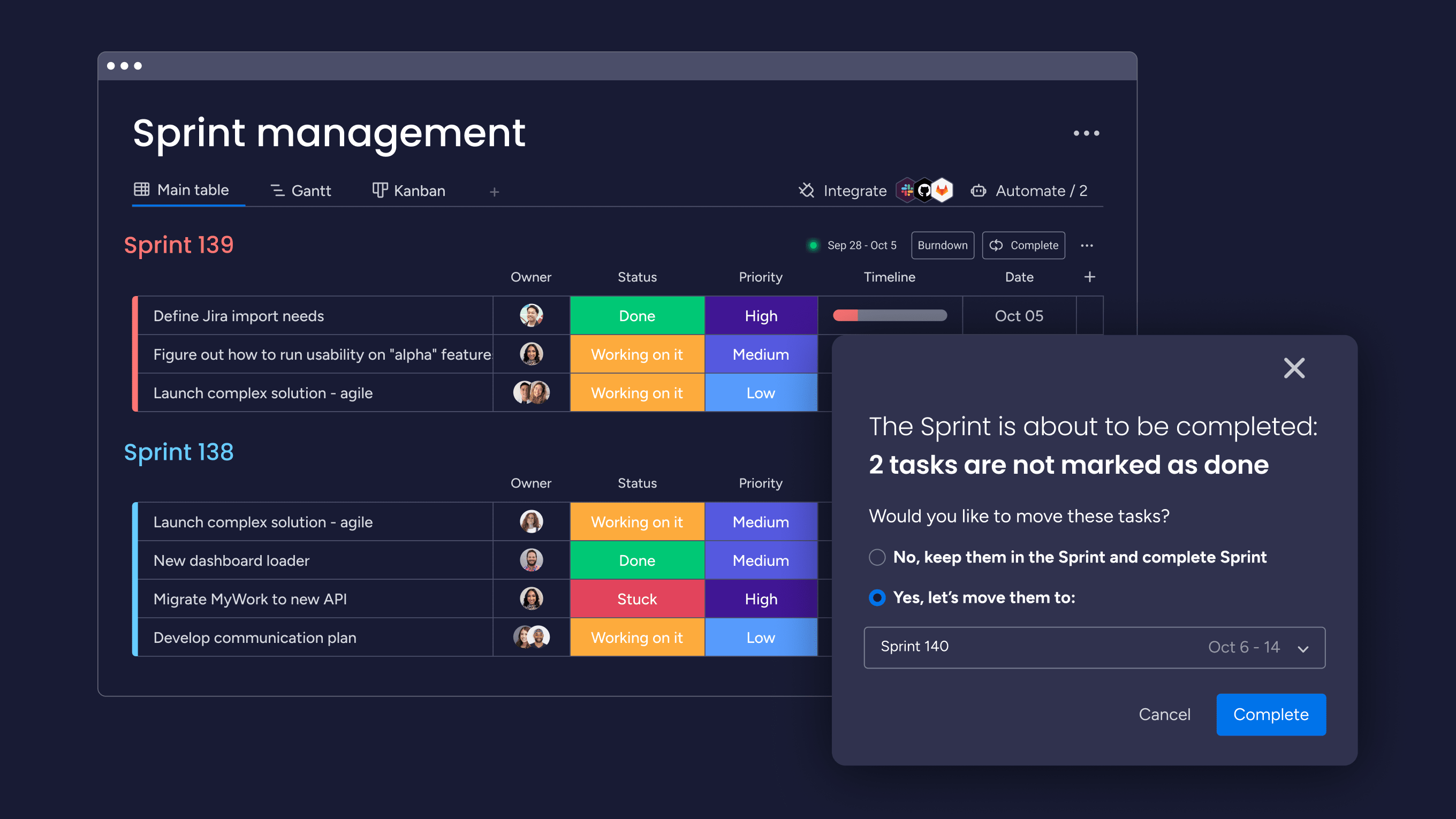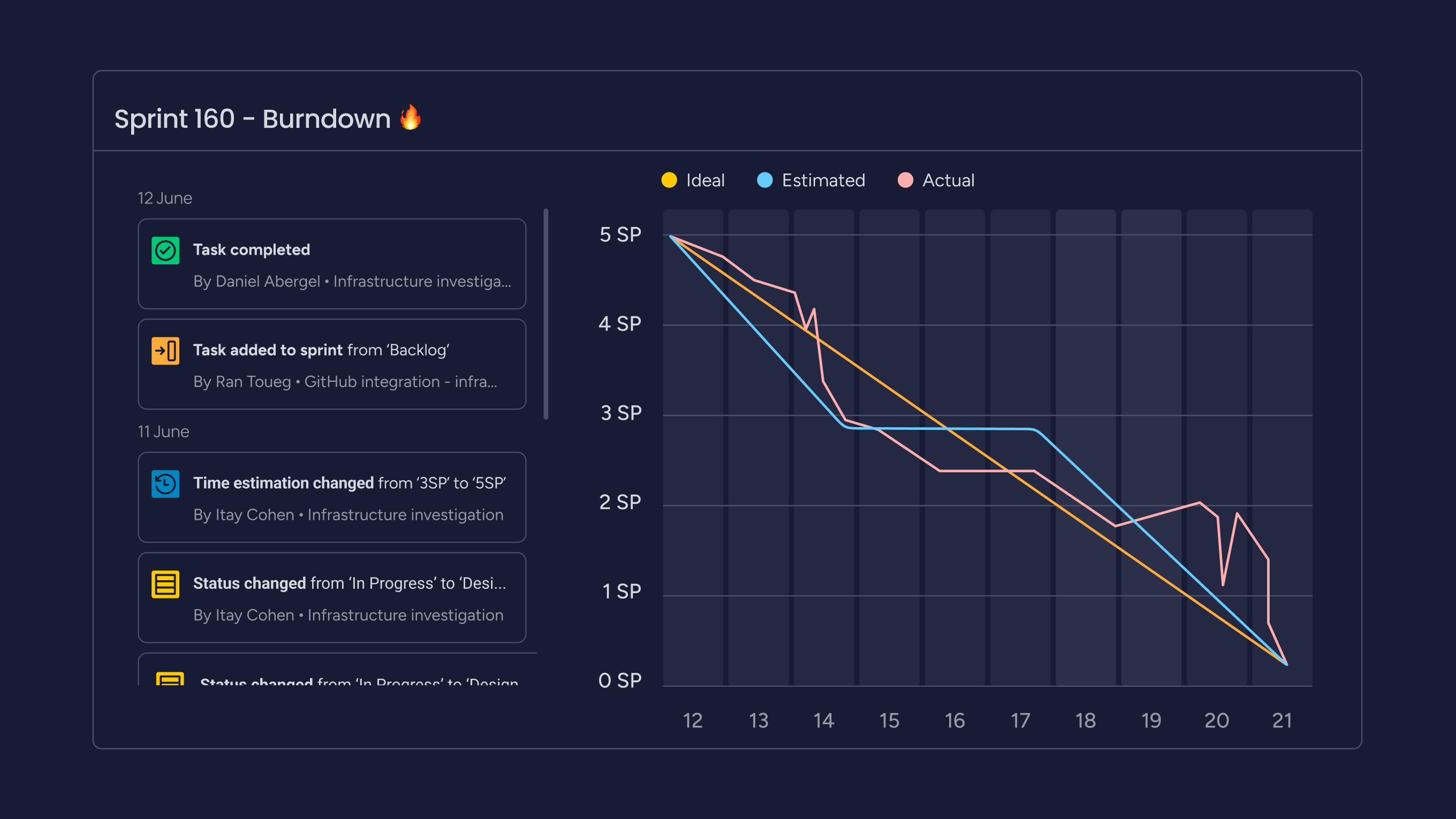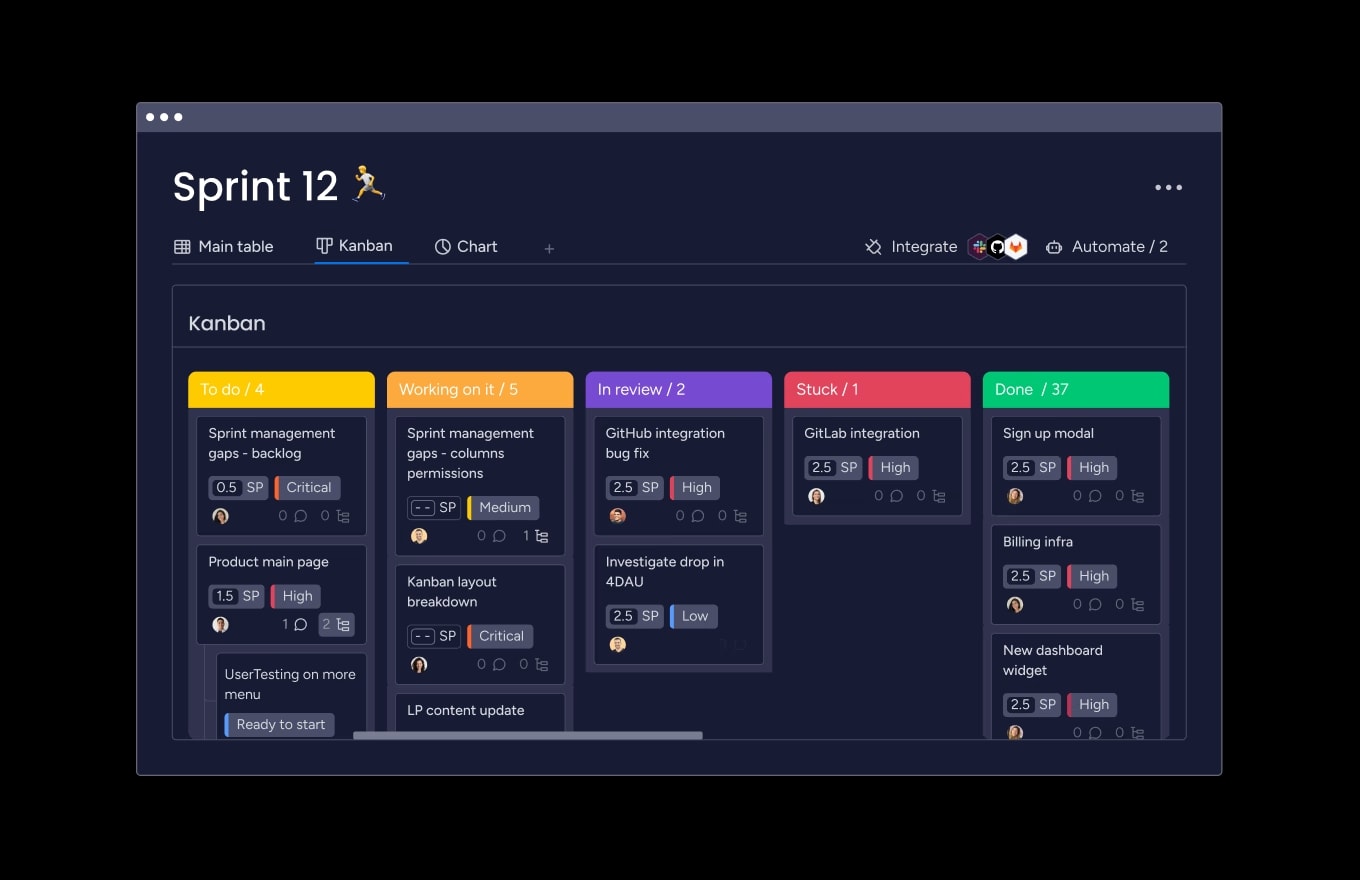The sprint backlog is a crucial component that helps Scrum teams maximize the value of each sprint by promoting focus, transparency, collaboration, flexibility, and continuous improvement in their work processes.
Without it, developers would likely drift, timescales slip, and sprints would stall. So, how do you ensure every sprint backlog is a success?
In this guide, we’ll cover the ins and outs of a sprint backlog, who owns it, and how it differs from a product backlog. You’ll also learn how to manage your sprint backlog with monday dev and keep your daily Scrums running like clockwork.
Try monday devWhat is a sprint backlog?
A sprint backlog is a list of tasks a development team plans to complete during a specific sprint — a short, time-boxed period, typically 2-4 weeks. It represents the team’s commitment and plan to deliver an increment of the product backlog during that sprint.
It’s a crucial Scrum artifact that enables the team members to plan, execute, and inspect their work during each sprint iteration, ultimately delivering a potentially releasable increment of the product.
What’s included in a sprint backlog?
A sprint backlog typically consists of the following key components:
- Sprint goal: A concise objective that describes the desired outcome or functionality to be delivered by the end of the sprint. It provides focus and direction for the team’s efforts during the sprint.
- Product backlog items (PBIs) or user stories: A subset of high-priority items from the product backlog that the team commits to completing during the sprint. These are typically user stories or features that contribute to the sprint goal.
- Tasks: A breakdown of the product backlog items or user stories into specific tasks required to complete each item. These tasks are estimated, prioritized, and assigned to team members.
- Task estimates: An estimate (often in story points or ideal hours) of the effort required to complete each task. This helps the team plan and track their progress.
- Task assignments: Each task is assigned to a specific team member responsible for its completion.
- Task status: The current status of each task — e.g. not started, in progress, and completed — is tracked and updated throughout the sprint.
- Burndown chart: A visual representation of the sprint’s remaining work (in story points or hours), helping the team track their progress.
Who owns the sprint backlog?
According to the Scrum framework, the development team owns the sprint backlog.
Although the entire Scrum team (product owner, Scrum master, and developers) collaborates during the sprint planning meeting to select items from the product backlog and define the sprint goal, the developers are solely responsible for deciding what they can commit to completing within the sprint.
So, while the product owner conducts the meeting and the Scrum master ensures everyone agrees on the sprint’s scope, it’s the developers who own and manage the sprint backlog throughout the sprint, updating it as needed to reflect the current state of work and any changes or adjustments required.
Sprint backlog vs. product backlog: What’s the difference?
The key differences between a sprint backlog and a product backlog are:
1. Scope and purpose
- Product backlog: A comprehensive list of all planned work for the entire product, including customer requests, new features, enhancements, and bug fixes. It represents the overall product vision and roadmap.
- Sprint backlog: A subset of the product backlog, containing only the items committed for completion within a specific sprint (time-boxed iteration, usually 2-4 weeks). It represents the plan for achieving the sprint goal.
2. Level of detail
- Product backlog: Items are typically high-level user stories or features with minimal details.
- Sprint backlog: Items from the product backlog are broken down into specific tasks, with estimates and assignments for each task.
3. Ownership and management
- Product backlog: Owned and managed by the product owner, who prioritizes items based on business value and stakeholder feedback.
- Sprint backlog: Owned and managed by the development team, which creates and updates it during sprint planning and daily standups.
4. Flexibility
- Product backlog: Continuously evolving and reprioritized based on changing requirements and feedback.
- Sprint backlog: Remains relatively fixed during the sprint, allowing the team to focus on committed work with minimal changes.
5. Timeframe
- Product backlog: Represents a long-term plan for the overall product vision and roadmap, spanning the entire product lifecycle.
- Sprint backlog: Represents a short-term plan for a specific sprint, typically 2-4 weeks.
To summarize: the product backlog provides a high-level, strategic view of the product’s direction, while the sprint backlog is a tactical plan for executing specific tasks — derived from the product backlog — within a sprint.
The best way to use the sprint backlog in your daily Scrum meetings
Here are some best practices for effectively using and managing the sprint backlog during your daily Scrum meetings.
Update task status and estimates
During the daily standup, each team member should provide an update on the tasks they worked on yesterday, including progress made and any remaining effort estimates. Update the sprint backlog accordingly by marking tasks as completed or adjusting remaining estimates.
Identify blockers and challenges
Team members should highlight any blockers or challenges they are facing with their assigned tasks. The sprint backlog can visualize these blockers, enabling the team to find solutions collaboratively.
Discuss dependencies
Review the sprint backlog to identify and discuss any dependencies between tasks or team members. This coordination helps ensure smooth workflow and progress toward the sprint goal.
Reprioritize and adjust
Based on the progress updates and any identified issues, the team can collaboratively decide to reprioritize tasks, split or merge tasks, or make other adjustments to the sprint backlog to stay on track.
Visualize progress
Use the sprint backlog, often represented as a Scrum board, to visually track the progress of tasks through different stages — e.g. To Do, In Progress, and Done. This transparency helps the team understand the overall sprint progress.
Focus on the sprint goal
While updating the sprint backlog, maintain focus on the overall sprint goal. Ensure that the team’s efforts align with achieving the desired outcome for the sprint.
Time-box the discussion
Adhere to the 15-minute time-box for the daily Scrum. To keep updates concise and focused, use techniques like pointing to the relevant tasks on the sprint backlog.
Involve the entire team
Encourage all team members to actively participate in the daily Scrum and contribute to the discussion around the sprint backlog. This fosters collaboration, shared understanding, and collective ownership.
Use the right software
Using the right software, like monday dev, to manage the sprint backlog will make your daily Scrum meeting even more effective.
Try monday devHow to manage your sprint backlog using monday dev
Built on the robust monday.com Work OS, monday dev ensures you have all the latest information at your fingertips in one collaborative platform. With multiple ways to visualize and manage your sprints, you can see the current team workload and which tasks are in the backlog when running your sprint planning meetings.
Creating and organizing the sprint backlog
From the main Tasks board in monday dev, teams can quickly create and organize their sprint backlog.
- Backlog group: monday dev has a dedicated “Backlog” group where you can store all unassigned tasks and user stories from the product backlog.
- Sprint groups: You can create new groups for each sprint to represent the sprint backlog, containing all tasks planned for that specific sprint.
- Adding tasks: You can add new tasks directly to a sprint group or move existing tasks from the backlog into a sprint by dragging and dropping them.
- Task details: For each task in the sprint backlog, you can capture details like status, priority, type (bug, feature, etc.), role (developer, designer, etc.), estimated story points or effort, and actual effort.
- Customizing columns: You can customize the columns to fit your workflow by adding columns for owners, status tracking, story points/effort estimation, and more.
Managing and tracking sprints
With monday dev, Scrum teams can easily manage their sprints from start to finish, tracking progress in one place with the sprint management solution.
- Sprint timeline: Each sprint group displays a timeline, helping you visualize the sprint duration.
- Active sprint indication: An “active” indicator shows which sprint the team is currently working on.
- Starting/Completing sprints: Use the “Start Sprint” and “Complete Sprint” buttons to activate or mark a sprint as done. Move incomplete tasks to another sprint or keep them in the completed one.

- Updates and communication: Team members can add updates, files, and notes and tag others within each task, facilitating collaboration and communication.
- Burndown charts: Story points or effort estimates feed directly into burndown charts, allowing you to track progress against the projected work for the sprint.

- Multiple views: View tasks in different formats like Kanban boards, sprint planning dashboards, and user-centric views showing tasks assigned to each team member.

- Multiple teams: If you have multiple Scrum teams, you can add separate sprint groups for each team within the same board.
Keep everyone on track with your sprint backlog
The sprint backlog provides a real-time picture of the tasks the development team plans to accomplish and achieve the sprint goal. It helps the entire Scrum team track daily progress, identify blockers, and make necessary adjustments during the sprint.
Using the sprint management solution in monday dev, teams can effectively create, organize, and manage their sprint backlogs, track progress, collaborate, and ensure successful sprint execution.
Try monday dev with a 14-day free trial and see how easy it is to manage your sprint backlog.
FAQs
How often do you need to update a sprint backlog?
While there are no strict rules, Scrum experts recommend that teams update the sprint backlog frequently, most likely in the daily Scrum meeting, to reflect the team's current understanding of the work and progress towards the sprint goal.
What is the difference between sprint planning and a sprint backlog?
Sprint planning is the meeting where the Scrum team plans the upcoming sprint, while the sprint backlog is the tangible output or plan created during that event, containing the specific tasks the development team will work on during the sprint.
How do you ensure the sprint backlog aligns with the sprint goal?
To align the sprint backlog with the sprint goal, teams should first define the sprint goal, carefully select backlog items that contribute to that goal, break them down into tasks, prioritize tasks accordingly, review and refine the backlog regularly, seek feedback from the product owner, and use visual tools to represent the alignment.
- Tags:
- Agile methodology
Don’t miss more quality content!
